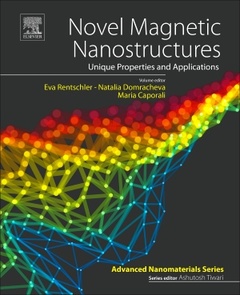Description
Novel Magnetic Nanostructures
Unique Properties and Applications
Micro and Nano Technologies Series
Coordinators: Domracheva Natalia, Caporali Maria, Rentschler Eva
Language: English
Subjects for Novel Magnetic Nanostructures:
490 p. · 19x23.3 cm · Paperback
Description
/li>Contents
/li>Readership
/li>Biography
/li>Comment
/li>
Novel Magnetic Nanostructures: Unique Properties and Applications reviews the synthesis, design, characterization and unique properties of emerging nanostructured magnetic materials. It discusses the most promising and relevant applications, including data storage, spintronics and biomedical applications. Properties investigated include electronic, self-assembling, multifunctional, and magnetic properties, along with magnetic phenomena. Structures range from magnetic nanoclusters, nanoparticles, and nanowires, to multilayers and self-assembling nanosystems. This book provides a better understanding of the static and dynamic magnetism in new nanostructures for important applications.
2. Metallacrowns reaching the nanosize regime
3. Multifunctional properties of g-Fe2O3 nanoparticles encapsulated into liquid-crystalline poly(propylene imine) dendrimer
4. Magnetic disorder in nanostructured materials
5. Self-assembly of smallest magnetic nanoparticles
6. Hybrid nanostructures for magnetoplasmonics
7. Highly responsive magnetoactive elastomers
8. Neel Effect: exploiting the non-linear behavior of superparamagnetic nanoparticles for applications in life sciences up to electrical engineering
9. Ferrimagnetic heterostructures for applications in magnetic recording
10. nanomagnetic supported catalysts
11. Spin and charge tunneling transport in magnetic tunnel junctions with embedded nanoparticles
12. Spin crossover nanoparticles
13. Magnetic metal-nonstoichiometric oxide nanocomposites: structure, transport and memristive properties
Materials Scientists and engineers, materials chemists, physicists, researchers working on nanomaterials
Maria Caporali is a Researcher in the Institute of Chemistry of Organometallic Compounds at the CNR in Florence, Italy. She is involved since many years in Phosphorus chemistry, including the activation and functionalization of white phosphorus with metal complexes, the synthesis of metal phosphides nanoparticles and their application in catalysis, and lately the functionalization of phosphorene, the P-analog of graphene, with transition metal nanoparticles.
Dr. Rentschler is a professor in the Institute of Inorganic Chemistry at the University of Mainz where she is responsible for managing the subject of bioinorganic chemistry. Her research involves the investigation of bio-inspired systems, inorganic and organic materials, molecular magnets and correlated spins. She leads a group whose current projects include focus on molecule-based magnetics, polymetallic exchange coupled systems, high nuclearity spin clusters, mixed valence complexes, ferric ring systems, butterfly-like complexes, and stable radical ligands.
- Provides an overview of the latest research on novel magnetic nanostructures, including molecular nanomagnets, metallacrown magnetic nanostructures, magnetic dendrimers, self-assembling magnetic structures, multifunctional nanostructures, and much more
- Reviews the synthesis, design, characterization and detection of useful properties in new magnetic nanostructures
- Highlights the most relevant applications, including spintronic, data storage and biomedical applications




